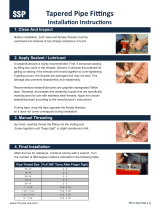
© ADB Airfield Solutions All Rights Reserved v
TABLE OF CONTENTS
A.0 Disclaimer / Standard Warranty.............................................................................................................................II
A.1 CE certification ..................................................................................................................... ii
A.2 ETL certification ................................................................................................................... ii
A.3 LED Product Guarantee ........................................................................................................... ii
A.4 Standard Product Guarantee ..................................................................................................... ii
A.5 All Products ......................................................................................................................... ii
A.6 Liability ..............................................................................................................................iii
A.7 © ADB BVBA ......................................................................................................................... iv
1.0 Safety .......................................................................................................................................................................1
1.1 HAZARD Icons used in the manual ............................................................................................... 1
1.1.1 Qualified Personnel ......................................................................................................... 1
1.2 To use this equipment safely: .................................................................................................... 2
1.2.1 Additional Reference Materials: .......................................................................................... 2
1.2.2 Intended Use ................................................................................................................. 2
1.2.3 Fasteners ..................................................................................................................... 2
1.2.4 Operation ..................................................................................................................... 3
1.2.5 Storage ........................................................................................................................ 3
1.2.6 Material Handling Precautions .............................................................................................3
1.2.7 Action in the Event of a System or Component Malfunction .......................................................... 4
1.2.8 Maintenance .................................................................................................................. 4
1.2.9 Maintenance and Repair ....................................................................................................4
2.0 ITCF LED Light ......................................................................................................................................................... 5
2.1 About this manual .................................................................................................................. 5
2.1.1 How to work with the manual ............................................................................................. 5
2.1.2 Record of changes ........................................................................................................... 5
2.2 Introduction ......................................................................................................................... 6
2.2.1 L852A-D, J & K ITCF ......................................................................................................... 6
2.2.1.1 Compliance with Standards .......................................................................................... 6
2.2.1.2 Uses...................................................................................................................... 6
2.2.1.3 Operating Conditions ................................................................................................. 6
2.2.1.4 Packaging ............................................................................................................... 6
2.2.1.5 Electrical Supply ...................................................................................................... 7
2.2.1.6 The ITCF Light Fixture ................................................................................................ 7
2.2.2 Typical Configuration ....................................................................................................... 7
2.2.2.1 Inner Pan Subassembly ............................................................................................... 8
2.2.2.2 Optical Unit L852A, B, C, J and ICAO Straight .................................................................... 8
2.2.2.3 Optical Unit L852D & K ............................................................................................... 8
2.3 Installation .......................................................................................................................... 9
2.3.1 Mechanical Requirements .................................................................................................. 9
2.3.2 Electrical Requirements ...................................................................................................11
2.3.3 Installing the Fixture ....................................................................................................... 12
2.3.3.1 Overview of Sequence of Work.................................................................................... 12
2.3.3.2 Safety Considerations............................................................................................... 13
2.3.3.3 Unpack the Unit ..................................................................................................... 13
2.3.3.4 Coding ................................................................................................................. 13
2.3.3.5 Verify Input Requirements and Equipment Needed ............................................................ 13
2.3.4 Snow Plow Ring Assembly ................................................................................................. 14
2.3.4.1 Installation on L-868 Base.......................................................................................... 16
2.3.5 Torquing and Installation Guidance for In-pavement Fixtures ...................................................... 17
2.3.5.1 Installation on a Shallow Base ..................................................................................... 17
2.4 Maintenance ....................................................................................................................... 18
2.4.1 L852 A-D ITCF Maintenance ............................................................................................... 18

























